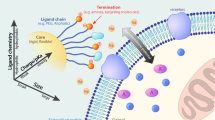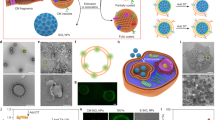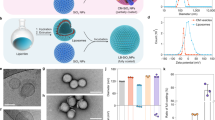Abstract
Nanoscale objects are typically internalized by cells into membrane-bounded endosomes and fail to access the cytosolic cell machinery. Whereas some biomacromolecules may penetrate or fuse with cell membranes without overt membrane disruption, no synthetic material of comparable size has shown this property yet. Cationic nano-objects pass through cell membranes by generating transient holes, a process associated with cytotoxicity. Studies aimed at generating cell-penetrating nanomaterials have focused on the effect of size, shape and composition. Here, we compare membrane penetration by two nanoparticle ‘isomers’ with similar composition (same hydrophobic content), one coated with subnanometre striations of alternating anionic and hydrophobic groups, and the other coated with the same moieties but in a random distribution. We show that the former particles penetrate the plasma membrane without bilayer disruption, whereas the latter are mostly trapped in endosomes. Our results offer a paradigm for analysing the fundamental problem of cell-membrane-penetrating bio- and macro-molecules.
This is a preview of subscription content, access via your institution
Access options
Subscribe to this journal
Receive 12 print issues and online access
$259.00 per year
only $21.58 per issue
Buy this article
- Purchase on Springer Link
- Instant access to full article PDF
Prices may be subject to local taxes which are calculated during checkout





Similar content being viewed by others
Change history
28 February 2013
In the version of this Article originally published, in the caption for Fig. 1 the following statement should have been included "Right-hand STM image in panel a reproduced with permission from ref. 30, © 2008 RSC." This error has been corrected in the PDF and HTML versions of the Article.
References
Weissleder, R. Molecular imaging in cancer. Science 312, 1168–1171 (2006).
Somers, R. C., Bawendi, M. G. & Nocera, D. G. CdSe nanocrystal based chem-/bio-sensors. Chem. Soc. Rev. 36, 579–591 (2007).
Lewin, M. et al. Tat peptide-derivatized magnetic nanoparticles allow in vivo tracking and recovery of progenitor cells. Nature Biotechnol. 18, 410–414 (2000).
West, J. L. & Halas, N. J. Engineered nanomaterials for biophotonics applications: Improving sensing, imaging, and therapeutics. Annu. Rev. Biomed. Eng. 5, 285–292 (2003).
El-Sayed, I. H., Huang, X. H. & El-Sayed, M. A. Selective laser photo-thermal therapy of epithelial carcinoma using anti-EGFR antibody conjugated gold nanoparticles. Cancer Lett. 239, 129–135 (2006).
Rosi, N. L. et al. Oligonucleotide-modified gold nanoparticles for intracellular gene regulation. Science 312, 1027–1030 (2006).
Han, G. et al. Light-regulated release of DNA and its delivery to nuclei by means of photolabile gold nanoparticles. Angew. Chem. Int. Ed. 45, 3165–3169 (2006).
Allen, T. M. & Cullis, P. R. Drug delivery systems: Entering the mainstream. Science 303, 1818–1822 (2004).
Choleris, E. et al. Microparticle-based delivery of oxytocin receptor antisense DNA in the medial amygdala blocks social recognition in female mice. Proc. Natl Acad. Sci. USA 104, 4670–4675 (2007).
Leroueil, P. R. et al. Nanoparticle interaction with biological membranes: Does nanotechnology present a janus face? Acc. Chem. Res. 40, 335–342 (2007).
Zorko, M. & Langel, U. Cell-penetrating peptides: mechanism and kinetics of cargo delivery. Adv. Drug Deliv. Rev. 57, 529–545 (2005).
Herbig, M. E., Assi, F., Textor, M. & Merkle, H. P. The cell penetrating peptides pVEC and W2-pVEC induce transformation of gel phase domains in phospholipid bilayers without affecting their integrity. Biochemistry 45, 3598–3609 (2006).
Takeuchi, T. et al. Direct and rapid cytosolic delivery using cell-penetrating peptides mediated by pyrenebutyrate. ACS Chem. Biol. 1, 299–303 (2006).
Thoren, P. E. G. et al. Uptake of analogs of penetratin, Tat(48-60) and oligoarginine in live cells. Biochem. Biophys. Res. Commun. 307, 100–107 (2003).
Patel, L. N., Zaro, J. L. & Shen, W. C. Cell penetrating peptides: Intracellular pathways and pharmaceutical perspectives. Pharm. Res. 24, 1977–1992 (2007).
Yu, J., Patel, S. A. & Dickson, R. M. In vitro and intracellular production of peptide-encapsulated fluorescent silver nanoclusters. Angew. Chem. Int. Ed. 46, 2028–2030 (2007).
Kostarelos, K. et al. Cellular uptake of functionalized carbon nanotubes is independent of functional group and cell type. Nature Nanotechnol. 2, 108–113 (2007).
Lovric, J. et al. Differences in subcellular distribution and toxicity of green and red emitting CdTe quantum dots. J. Mol. Med. 83, 377–385 (2005).
Hu, Y. et al. Cytosolic delivery of membrane-impermeable molecules in dendritic cells using pH-responsive core–shell nanoparticles. Nano Lett. 7, 3056–3064 (2007).
Tkachenko, A. G. et al. Multifunctional gold nanoparticle-peptide complexes for nuclear targeting. J. Am. Chem. Soc. 125, 4700–4701 (2003).
Shukla, R. et al. Biocompatibility of gold nanoparticles and their endocytotic fate inside the cellular compartment: A microscopic overview. Langmuir 21, 10644–10654 (2005).
Colvin, V. Correlating the physical and chemical properties of nanoparticles to their biological activity. Environ. Mol. Mutagen. 48, 533–533 (2007).
Jackson, A. M., Myerson, J. W. & Stellacci, F. Spontaneous assembly of subnanometre-ordered domains in the ligand shell of monolayer-protected nanoparticles. Nature Mater. 3, 330–336 (2004).
Jackson, A. M., Hu, Y., Silva, P. J. & Stellacci, F. From homoligand- to mixed-ligand-monolayer-protected metal nanoparticles: A scanning tunneling microscopy investigation. J. Am. Chem. Soc. 128, 11135–11149 (2006).
DeVries, G. A. et al. Divalent metal nanoparticles. Science 315, 358–361 (2007).
Daniel, M. C. & Astruc, D. Gold nanoparticles: Assembly, supramolecular chemistry, quantum-size-related properties, and applications toward biology, catalysis, and nanotechnology. Chem. Rev. 104, 293–346 (2004).
Manea, F., Houillon, F. B., Pasquato, L. & Scrimin, P. Nanozymes: Gold-nanoparticle-based transphosphorylation catalysts. Angew. Chem. Int. Ed. 43, 6165–6169 (2004).
Kisailus, D., Najarian, M., Weaver, J. C. & Morse, D. E. Functionalized gold nanoparticles mimic catalytic activity of a polysiloxane-synthesizing enzyme. Adv. Mater. 17, 1234 (2005).
Templeton, A. C., Wuelfing, M. P. & Murray, R. W. Monolayer protected cluster molecules. Acc. Chem. Res. 33, 27–36 (2000).
Uzun, O. et al. Water-soluble amphiphilic gold nanoparticles with structured ligand shells. Chem. Commun. 196–198 (2008).
Kang, S. Y. & Kim, K. Comparative study of dodecanethiol-derivatized silver nanoparticles prepared in one-phase and two-phase systems. Langmuir 14, 226–230 (1998).
Tan, H., Zhan, T. & Fan, W. Y. Direct functionalization of the hydroxyl group of the 6-mercapto-1-hexanol (MCH) ligand attached to gold nanoclusters. J. Phys. Chem. B 110, 21690–21693 (2006).
Shen, Z. H., Reznikoff, G., Dranoff, G. & Rock, K. L. Cloned dendritic cells can present exogenous antigens on both MHC class I and class II molecules. J. Immunol. 158, 2723–2730 (1997).
Richard, J. P. et al. Cell-penetrating peptides—A reevaluation of the mechanism of cellular uptake. J. Biol. Chem. 278, 585–590 (2003).
Parak, W. J. et al. Cell motility and metastatic potential studies based on quantum dot imaging of phagokinetic tracks. Adv. Mater. 14, 882–885 (2002).
Wilhelm, C., Gazeau, F., Roger, J., Pons, J. N. & Bacri, J. C. Interaction of anionic superparamagnetic nanoparticles with cells: Kinetic analyses of membrane adsorption and subsequent internalization. Langmuir 18, 8148–8155 (2002).
Verma, A., Simard, J. M., Worrall, J. W. E. & Rotello, V. M. Tunable reactivation of nanoparticle-inhibited beta-galactosidase by glutathione at intracellular concentrations. J. Am. Chem. Soc. 126, 13987–13991 (2004).
Meister, A. & Anderson, M. E. Glutathione. Annu. Rev. Biochem. 52, 711–760 (1983).
Hong, R. et al. Glutathione-mediated delivery and release using monolayer protected nanoparticle carriers. J. Am. Chem. Soc. 128, 1078–1079 (2006).
Cedervall, T. et al. Detailed identification of plasma proteins adsorbed on copolymer nanoparticles. Angew. Chem. Int. Ed. 46, 5754–5756 (2007).
Hong, S. P. et al. Interaction of polycationic polymers with supported lipid bilayers and cells: Nanoscale hole formation and enhanced membrane permeability. Bioconjug. Chem. 17, 728–734 (2006).
Hong, S. P. et al. Interaction of poly(amidoamine) dendrimers with supported lipid bilayers and cells: Hole formation and the relation to transport. Bioconjug. Chem. 15, 774–782 (2004).
Zhang, L. J., Rozek, A. & Hancock, R. E. W. Interaction of cationic antimicrobial peptides with model membranes. J. Biol. Chem. 276, 35714–35722 (2001).
Nel, A., Xia, T., Madler, L. & Li, N. Toxic potential of materials at the nanolevel. Science 311, 622–627 (2006).
Acknowledgements
This work was supported by the National Science Foundation (CAREER Award) and the NHLBI TPEN program (U01-HL080731). F.S. is grateful to the Packard Foundation for their generous award.
This paper is dedicated to A. Mayes in recognition of the mentor role she had for both corresponding authors.
Author information
Authors and Affiliations
Contributions
D.J.I. and F.S. conceived the research question. A.V., O.U., D.J.I. and F.S. designed the experiments and analysed all of the data. The biological experiments were carried out by A.V. and Yu.H.; TEM experiments were carried out by A.V. and N.W., STM by Yi.H. and S.C., nanoparticle synthesis and characterization by O.U. and H.S.H. The paper was written by A.V., O.U., D.J.I. and F.S.
Corresponding authors
Supplementary information
Supplementary Information
Supplementary Figures S1–S15 and Supplementary Table 1 (PDF 878 kb)
Rights and permissions
About this article
Cite this article
Verma, A., Uzun, O., Hu, Y. et al. Surface-structure-regulated cell-membrane penetration by monolayer-protected nanoparticles. Nature Mater 7, 588–595 (2008). https://doi.org/10.1038/nmat2202
Received:
Accepted:
Published:
Issue Date:
DOI: https://doi.org/10.1038/nmat2202
This article is cited by
-
Biological Interaction and Imaging of Ultrasmall Gold Nanoparticles
Nano-Micro Letters (2024)
-
A drug-free nanozyme for mitigating oxidative stress and inflammatory bowel disease
Journal of Nanobiotechnology (2022)
-
Organelle-targeted therapies: a comprehensive review on system design for enabling precision oncology
Signal Transduction and Targeted Therapy (2022)
-
Defining Endocytic Pathways of Fucoidan-Coated PIBCA Nanoparticles from the Design of their Surface Architecture
Pharmaceutical Research (2022)
-
Detection of magnetic iron nanoparticles by single-particle ICP-TOFMS: case study for a magnetic filtration medical device
Analytical and Bioanalytical Chemistry (2022)



